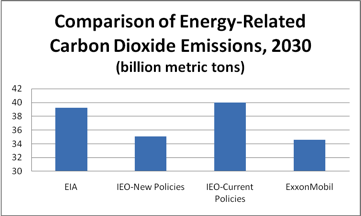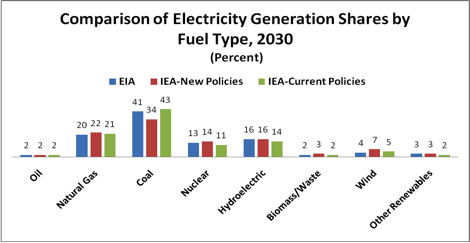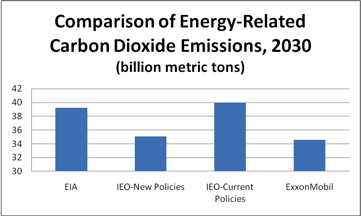Fossil fuels are dominating the world’s energy market—a trend that will last for at least the next 20 to 25 years, the leading energy forecasters contend. According to these forecasters, it does not matter whether policies remain the same or whether anti-fossil fuel policies are enacted—fossil fuels will continue to produce 75 to 80 percent of the world’s energy by 2030.
ExxonMobil[i] recently joined the Energy Information Administration (EIA)[ii] and the International Energy Agency (IEA)[iii]in that determination when they released their energy outlook last month. While the EIA assumes no regulatory or legislative changes, ExxonMobil includes policy changes regarding energy efficiency gains and policies to address the risk of climate change. The IEA addresses both through a current policies case and a new policies case. In the new policies case, IEA assumes that governments will implement announced policies such as cutting greenhouse gas emissions and removing fossil fuel subsidies with subsequent impact on technological improvements and innovations.
But, in each case, fossil fuels dominate the energy picture being the fuels of choice for many developing countries to further their economic growth. By 2030, fossil fuels are expected to provide 79 percent of the world’s energy, according to ExxonMobil, who sees energy demand in the developing countries growing by more than 70 percent in 2030 as those countries require more transportation fuels to power their vehicles and more electricity for appliances, lighting, and other comforts. EIA and IEA concur with the dominance of fossil fuels, but with different shares. In EIA’s International Energy Outlook, fossil fuels represent 80 percent of the energy market in 2030; in IEA’s World Energy Outlook, fossil fuels represent 79 percent in its current policy case and 75 percent in its new policies case. Either way, fossil fuels remain the dominant energy suppliers in 2030.
A major difference between ExxonMobil’s outlook versus the other two outlooks is the ranking of the three fossil fuels toward meeting global energy demand. They all agree that petroleum will rank first. But, ExxonMobil places natural gas second, while EIA and IEA in both the current policies and new policies cases place coal second. ExxonMobil’s higher ranking of natural gas is due to the fuel’s increased use for electricity generation replacing aging coal plants in developed countries and producing needed new electricity in developing nations, its lower carbon dioxide emissions output compared to coal, and technological advances that have increased supplies of liquefied natural gas worldwide and that have made shale gas accessible in North America. By 2030, Exxon Mobil expects 26 percent of the world’s energy consumption to be from natural gas, while EIA and IEA expect shares to be at 23 percent and 22 percent, respectively. Between 2005 and 2030, ExxonMobil projects that demand for natural gas by the electric power sector will increase by 85 percent.
Energy Demand
ExxonMobil sees energy demand in the countries of the Organization for Economic Development and Cooperation (OECD) as flat even though economic activity increases by 60 percent, while the non-OECD countries led by China will see their energy demand increase by 71 percent between 2005 and 2030, for a world increase of 36 percent. Efficiency improvements are a major factor in ExxonMobil’s forecast keeping energy demand increases, particularly for developed countries, down.
Even though ExxonMobil expects 400 million more cars on the road by 2030, gasoline demand declines in their forecast due to efficiency improvements and increased numbers of hybrid and advanced vehicles. While Asia’s demand for transportation fuels for light duty vehicles is expected to rise by 80 percent between 2005 and 2030, that demand will be more than compensated by OECD countries whose transportation fuel demand for light duty vehicles will drop, by 20 percent for the United States and 33 percent for Europe by 2030. Overall, however, transportation fuel demand including rail, marine, aviation, and light and heavy duty vehicles, is expected to increase by nearly 40 percent in ExxonMobil’s forecast led by the Asian countries whose demand is expected to nearly double, due to increased economic activity and rising incomes.
EIA and IEA both expect minor increases in energy demand in the OECD countries by 2030, by 3 percent in IEA’s new policies case, 7 percent in IEA’s current policies case, and by 10 percent in IEA’s reference case compared to current levels. But energy demand in the non-OECD countries is expected to increase more by 53 to 64 percent in the IEA cases, and 66 percent in the EIA reference case. Overall, transportation demand is expected to increase by 32 to 38 percent in the IEA and EIA cases by 2030, and for the non-OECD countries by 83 to 100 percent, somewhat similar to ExxonMobil’s forecast.
Electricity Generation Comparisons[1]
Coal remains the dominant fuel for electricity generation in 2030 for all forecasts, but its share varies widely based on the assumptions with IEA’s current policies’ forecasts giving coal a 43 percent share and EIA’s forecast giving coal a 41 percent share of the electric generation market in 2030. When new policies are considered by IEA, coal’s share shrinks to 34 percent. Natural gas ranks second in the generation market for all the forecasts with its share ranging from 20 percent for EIA to 22 percent for IEA’s New Policies case. EIA and IEA are pessimistic on nuclear power’s growth with its share ranging from 11 to 14 percent in 2030, the higher end of that range equal to its share in 2008.
Hydroelectric power dominates the renewable energy market with its share between 14 and 16 percent of the generation market in 2030. In 2008, hydroelectric power represented 16 percent of the generation market. Wind power’s share in 2030 ranges between 4 and 7 percent, the higher figure a result of government support in IEA’s new policies case. Biomass, waste, geothermal and solar power all remain with low shares due to their higher cost and/or their more limited availability. IEA in its new policies scenario is the most bullish on renewable energy, but the agency admits that heavy subsidies will be required if renewable growth is to meet the agency’s new policies forecast.
China Leads Demand Growth
All forecasters see China leading the world in energy growth. EIA expects China’s energy use to be 46 percent greater than that of the United States in 2030, which is similar to ExxonMobil’s forecast at 45 percent. For IEA, the disparity is even greater. In the current policies case, China’s energy use in 2030 is 66 percent higher than that of the United States, and in the new policies case, it is 56 percent higher. In the IEA cases, China increases its share of the energy market from 17 percent today to 22 in the new policies case and 23 percent in the current policies case. In EIA’s forecast, China consumes 24 percent of the world’s energy consumption in 2030. China has the lowest share of the energy market in ExxonMobil’s forecast — 21 percent.
Energy-Related Carbon Dioxide Emissions
Energy-related carbon dioxide emissions vary between 34.6 and 40.0 billion metric tons in 2030, depending on whether the assumption is current policies or new policies. The new policies assumptions of the IEA and those of ExxonMobil reduce global energy-related carbon dioxide emissions in 2030 by about 12 percent from what they would have been with current policies. In these scenarios, the developed countries make progress in reducing emissions because of technologies that improve the efficiency of energy use and government support to induce renewables into the market. In developing countries, just bringing energy to millions of people without electricity, transportation, and modern cooking devices spurs growth in energy demand that exceeds the energy reductions due to efficiency gains in developed countries.
Conclusion
What is most interesting from these forecasts is that regardless of whether policies are instituted to limit greenhouse gas emissions or not, the expected range in global energy shares of fuels over the next 20 years is not great. Fossil fuels are expected to dominate with 75 to 80 percent of the energy market. Nuclear’s share is expected to remain in the 6 to 8 percent range of total energy consumption in 2030, with a greater market share for those forecasts that assume new policies. Renewables, including hydroelectric power, are expected to command a 14 to 17 percent share of the market, depending on policies in place to promote them. The question to policy makers should be: “How much effort and money do we want to spend to gain such little change?”
[1] Because ExxonMobil reports its generation numbers in non-electric units, its forecast for electric generation is not comparable to that of EIA and IEA.
[i] ExxonMobil, The Outlook for Energy, http://www.exxonmobil.com/Corporate/energy_outlook_dm.aspx and http://www.exxonmobil.com/corporate/files/news_pub_eo.pdf
[ii] Energy Information Administration, International Energy Outlook 2010, http://www.eia.doe.gov/oiaf/ieo/index.html
[iii] International Energy Agency, World Energy Outlook 2010, http://www.worldenergyoutlook.org/docs/weo2010/WEO2010_ES_English.pdf and http://oce.iea.org/weo2010annexa.xls






